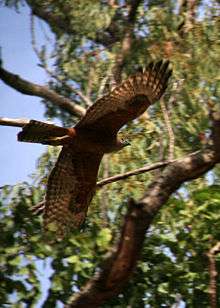Red goshawk
| Red goshawk | |
|---|---|
 | |
| Scientific classification | |
| Kingdom: | Animalia |
| Phylum: | Chordata |
| Class: | Aves |
| Order: | Accipitriformes |
| Family: | Accipitridae |
| Genus: | Erythrotriorchis |
| Species: | E. radiatus |
| Binomial name | |
| Erythrotriorchis radiatus (Latham, 1801) | |
The red goshawk (Erythrotriorchis radiatus) is probably the rarest Australian bird of prey. It is found mainly in the savanna woodlands of northern Australia, particularly near watercourses. It takes a broad range of live prey, mostly birds.
Taxonomy
The red goshawk was first described by the English ornithologist John Latham in 1801 under the binomial name Falco radiatus.[2]
The species used to be regarded as a very large member of the goshawk subfamily, Accipitrinae, but it is now believed that the resemblance to these other birds is convergent. Experts now group the red goshawk with the superficially dissimilar black-breasted buzzard Hamirostra melanosternon and square-tailed kite Lophoictinia isura as one of the Australasian old endemic raptors. It is believed that the ancestors of these birds, possibly together with a handful of species from South-east Asia and Africa, occupied Gondwana and over millions of years have diverged into their current forms.
Gene sequencing studies have found a relationship between Hamirostra and Lophoictinia, however samples had not been obtained from Erythrotriorchis.
Description
Plumage is generally rufous; on the head streaked with black and white, having more white on the face and throat; on the upper surfaces (body and upperwings) marked with black. Flight feathers and tail are barred grey, dark above and light below. Underside (belly and underwing coverts) are rufous with slight black ticking. The female has a paler belly than the male. Juveniles (first year) have less streaking on the head.[3]
Adults have yellow irides[3] (brown to yellow in the male);[4] juveniles brown. The cere and skin around the eye vary from pale-blue in the juvenile through pale blue-grey to pale-grey in the adult. Adults' legs and feet are yellow; juveniles are pale grey, cream, or pale yellow.[4]
Wings are long, broad and fingered at the tips.[3] Its long wings are unlike the short wings of the Accipiter goshawks.[4] Its tail is long and broad;[3] square-tipped and about half its total length.[4] It has a robust bill, slight brow ridge, and very heavy feet with bare tarsi having scutellate scale pattern.[4]
Pattern of direct flight is described as "sometimes leisurely, rather heavy and crow-like, with sustained flapping". Pursuit is "powerful and energetic with deep, fluid wing beats, like a fast-flying Brown Falcon". It soars with wings raised in a slight dihedral, almost flat; glides with wings flat or slightly bowed; and sometimes stoops with closed wings.[4]
Size is 45–60 cm long, with 110–135 cm wingspan. Males weigh 635 g, females 1100–1400 g. The female is similar in size to a little eagle, and the male to a female brown falcon.[4]
Distribution and habitat
Sites identified by BirdLife International as being important for red goshawk conservation are Lilyvale in Far North Queensland, Kakadu Savanna and the Tiwi Islands in the Northern Territory, and Mornington Sanctuary in the Kimberley region of Western Australia.[5]
Behaviour
Breeding
The nest is built in an exposed fork of a tall emergent tree. It is a stick platform lined with green leaves, 60–120 cm across and 30–50 cm deep.[4]
The egg-laying season is from May to October in the tropical north, and August to October in the east. Incubation takes 40 days, the nestling period 51–53 days, and juveniles remain dependent for 2–3 months.[4]
Diet
Red goshawks eat mostly birds, especially parrots and pigeons; rarely they also prey on mammals, reptiles, and large insects.
Early and late in the day, they hunt from concealed perches in the trees. In the middle of the day, they use long transects, quartering through or above the canopy, or search from a high soaring position. They attack by a stealthy glide, direct chase, or may stoop from a height.[4]
Status
The red goshawk is listed nationally as vulnerable under the federal Environmental Protection and Biodiversity Conservation Act 1999 EPBC and is listed as endangered in Queensland and New South Wales and vulnerable in the Northern Territory. It is also listed under the Convention on International Trade in Endangered Species of Wild Fauna and Flora CITES.[6]
The species is sparsely dispersed throughout its range across Australia but recent significant declines have been cause for concern, the main threats and causes of declines in eastern Australia have been attributed to clearing of forests and woodlands for agriculture which leads to degradation of remaining habitat, reduced available prey and reduction in suitable nesting sites.[6]
The protection of remaining intact habitat and the recovery of suitable habitat through rehabilitation through regulation on land clearing is an important conservation management tool for their survival.[6]
References
- ↑ BirdLife International (2012). "Erythrotriorchis radiatus". IUCN Red List of Threatened Species. Version 2013.2. International Union for Conservation of Nature. Retrieved 26 November 2013.
- ↑ Latham, John (1801). Supplementum indicis ornithologici sive systematis ornithologiae (in Latin). London: Leigh & Sotheby. p. xii.
- 1 2 3 4 Simpson, Ken; Day, Nicolas (2004). Field guide to the birds of Australia (7th ed.). Camberwell, Victoria: Penguin Group (Australia). p. 122. ISBN 0 670 04180 7.
- 1 2 3 4 5 6 7 8 9 10 Debus, Stephen J. S. (1998). The birds of prey of Australia: a field guide. Melbourne: Oxford University Press Australia. pp. 35–39. ISBN 0 19 550624 3.
- ↑ "Red-Goshawk". Important Bird Areas. BirdLife International. 2012. Retrieved 2012-10-30.
- 1 2 3 Environment, Department of the (2012). "National recovery plan for the red goshawk (Erythrotriorchis radiatus)". Retrieved 25 April 2014.
